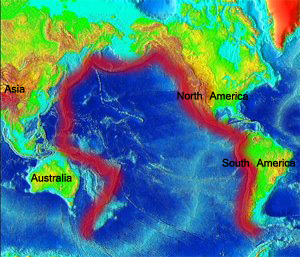Super Happy Volcano Time
Blog About Volcanoes!
Cluster Map
Friday 30 March 2012
Thursday 29 March 2012
Pompeii
Pompeii is a Roman city that was covered by the ash of the volcano of Vesuvius after it erupted in 79 AD. The city was undiscovered until 1700. Archaeologists began clearing the ash away to find the perfectly preserved city. Even the expressions on the faces of the civilians watching the ash pour down on them could still be seen! Vesuvius hadn't erupted 1800 years so the eruption was massive. There wasn't a usual eruption with lava, this eruption was just ash and rock. There was so much ash that it completely covered two cities! While the ash was coming down over the land there were also rocks falling from the sky called pumice. The eruption was just under 24 hours long and in this time more than 4 cubic kilometers of material came out of Vesuvius!

Preserved remains of a Pompeii civilian

Mt. Vesuvius

Preserved remains of a Pompeii civilian

Mt. Vesuvius
Pacific Ring of Fire
The Pacific ring of fire is the name given to the zone around the pacific plate where volcanoes and earthquakes frequently occur. It is around 40,000 km long! 90 percent of the worlds earthquakes occur here and 81 percent if the largest earthquakes happen here! It is a result of plate tectonics and movements or collisions of different plates.
There's a lot of volcanoes in the ring. Some famous ones are Mt. Saint Helens, Cotopaxi, Azul and Mt. Fuji.

There's a lot of volcanoes in the ring. Some famous ones are Mt. Saint Helens, Cotopaxi, Azul and Mt. Fuji.

Friday 23 March 2012
Worlds Tallest Active Volcano
The worlds tallest volcano is Tupungato in Chile. It is 21,500 feet tall! It wasn't classified as the tallest active volcano until it erupted in 1986. Before it erupted Cotopaxi was the tallest at 19,350 feet.
Tupungato's eruption in 1986 was only an ash eruption which didn't do much damage at all.
There was a scare in 1987 that it would erupt again except this time they thought it wouldn't just be ash, it would be a large eruption which would melt the glacier in the area which could cause huge damages. It didn't erupt but they are still monitoring it's activity.

Tupungato's eruption in 1986 was only an ash eruption which didn't do much damage at all.
There was a scare in 1987 that it would erupt again except this time they thought it wouldn't just be ash, it would be a large eruption which would melt the glacier in the area which could cause huge damages. It didn't erupt but they are still monitoring it's activity.
Friday 2 March 2012
Volcano Basics
A volcano is a conical hill or mountain formed by material from the mantle being forced through an opening or vent in the Earth's crust. There are three types of volcanoe. The first is active. These are volcanoes that have erupted in the last recently and is likely to erupt again. Mount Etna in Sicily is an active volcano. The second is dormant. These are volcanoes that havent erupted or shown signs of erupting for 2000 years but could still become active in the future. Mount Baker in Washington is a dormant volcano. The third is extinct. An extinct volcano is one that will never erupt again. The sugarloaf in Ireland is an extinct volcano.

This photo is from a website called http://www.geography.learnontheinternet.co.uk/
It is a simple diagram of a volcano but it explains a volcanoe really well.
www.geo.mtu.edu/volcanoes/world.html I did not make this website and I don't take credit for it
This page shows all the active volcanoes on earth. You can click each one to find out more information on it.

This photo is from a website called http://www.geography.learnontheinternet.co.uk/
It is a simple diagram of a volcano but it explains a volcanoe really well.
www.geo.mtu.edu/volcanoes/world.html I did not make this website and I don't take credit for it
This page shows all the active volcanoes on earth. You can click each one to find out more information on it.
Thursday 23 February 2012
My First Blog
Hello, I am Josh! This is my first blog. I will be posting once a week about The Geography of Volcanoes! If you are interested in volcanoes or wish to learn more about them you should take time to read it. I hope you enjoy!
Subscribe to:
Posts (Atom)